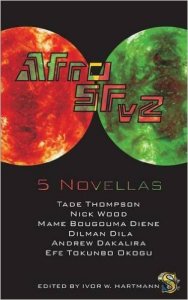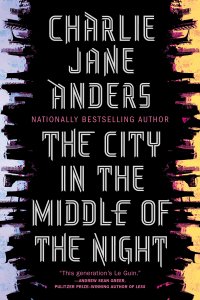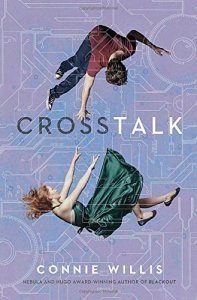Karen Burnham reviews AfroSF v2
AfroSF v2, Ivor W. Hartmann, ed. (StoryTime 978-91-982913-1-5, $16.00, 488pp, pb) December 2015.
 In 2015 editor Ivor W. Hartmann returned to the theme of his 2012 anthology, AfroSF: Science Fiction by African Writers. While the original volume contained stories by over 20 authors, this second volume takes a riskier approach, presenting five novellas by six authors. The novella is sometimes called the perfect vehicle for science fiction: long enough for all the necessary world building without getting too bogged down in details. However, they have often proved a tough sell in a marketplace that prefers fiction short enough to read on a lunch break or epic trilogies to fill the reading hours of several months.
In 2015 editor Ivor W. Hartmann returned to the theme of his 2012 anthology, AfroSF: Science Fiction by African Writers. While the original volume contained stories by over 20 authors, this second volume takes a riskier approach, presenting five novellas by six authors. The novella is sometimes called the perfect vehicle for science fiction: long enough for all the necessary world building without getting too bogged down in details. However, they have often proved a tough sell in a marketplace that prefers fiction short enough to read on a lunch break or epic trilogies to fill the reading hours of several months.
Still, anyone willing to take a risk on a collection of long short fiction will find their attention immediately grabbed by ‘‘The Last Pantheon’’ by Tade Thompson & Nick Wood. It opens with two superheroes battling it out for supremacy, both members of an alien race that crash-landed on our planet 50,000 years ago. The tale is told in the modern era (2015), the 1960s and ’70s, with flashbacks to earlier times in the 19th century and all the way back to the original crash landing. Thompson and Wood use these superheroes as a lens for examining the last 50 years of African history. Superheroes aren’t necessarily known for their political acumen, and Black-Power and Pan-African are clearly more comfortable throwing punches than dictating political realities. The one thing that the story has to elide is the question: where were these guys when the European powers were initially infiltrating Africa, starting the slave trade, and carving up the continent? None of the flashbacks happen to hit the 15th through 18th centuries. That said, there is a lot here for those interested in politics of different African countries and how superhero tropes can be used to illuminate political viewpoints.
‘‘Hell Freezes Over’’ by Mame Bougouma Diene is a post-apocalyptic tale. In this a post-climate change future much of the world is underwater. The human race has split up into Fish, Moles, Bees, and Beasts, each sub-race specializing in different tasks in order to keep the whole alive. For a while the Fish are ascendant and enslave the Moles; later the tables turn and turn again. Political intrigues between the different races dominate the story. The first half suffers from the lack of a clear protagonist, but in the second half the power dynamics play out much more clearly. The story wisely rejects utopian solutions to a dystopian future.
‘‘The Flying Man of Steel’’ by Dilman Dila also imbues a central character with superpowers. At the beginning of the story a young man named Kera is fleeing as his village (in a country not specified) is attacked. As he and his father seek to hide they break through to the hiding place of an ancient race, and something changes his father. As the village regroups and seeks to deal with their new reality, Kera’s father starts channeling new technology. Kera takes it and tries to wield power, but his actions generally make matters worse. The mayor and school teacher from the village start radicalizing, and as an individual Kera isn’t very effective against government troops. The ending of this story is very dark, even darker than the preceding two stories.
‘‘VIII’’ by Andrew Dakalira involves a series of mysterious happenings in Malawi that resolve into an alien invasion scenario. There are some particularly interesting characters here, and a good selection of viewpoints. The downside is that it reads like the beginning of a novel instead of a complete story in its own right.
Hartmann closes this volume with a piece of political satire by Efe Tokunbo Okogu. ‘‘An Indigo Song for Paradise’’ is by far the weirdest story here. The main characters come from many different segments of this city surrounded by wasteland, a setting adaptable to many different kinds of story – and Okogu wants to tell all of them, all at once. With tirades about corporations, Christmas, Colonialism, and chemicals, there are no end to his targets. But the fascinatingly odd setting and over the top characters somehow keep the whole thing from going off the rails.
It is gratifying to see science fiction from around the world getting a little more traction. Hartmann should be commended for giving voice to authors who haven’t gotten much genre attention, and for providing us with a wide sampling of what African authors have to offer. Focusing only on science fiction and, in this volume, only on novellas, are risky moves that mostly pay off. I look forward to future volumes in the series, if and when Hartmann is able to continue the project.






